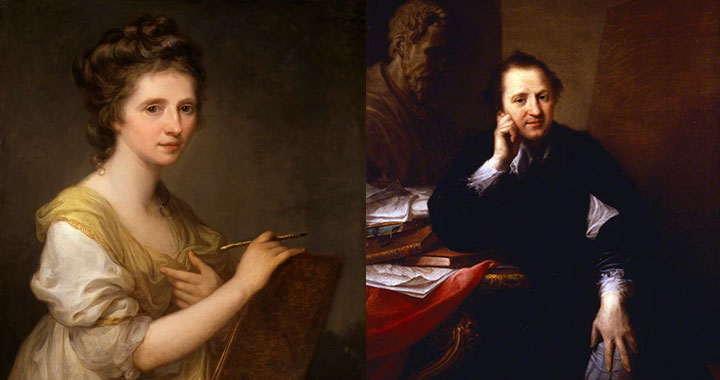Angelica Kauffman (1741-1807), who was a founder member of the Royal Academy and one of the most soughtafter portrait painters of her generation, is the subject of a major retrospective Exhibition at the Royal Academy, the first of its type in Britain in my lifetime.

The press release from the R.A. describes her as “one of the most celebrated artists of the 18th Century” and indeed she was. She was born in Switzerland and trained under her father before moving to various cities in Italy, ending up in Rome in 1763 where she became friends with Nathaniel Dance, the English portrait and history painter.
He, like many of his male contemporaries, fell under the spell of Angelica and sent her portrait of the actor, David Garrick, painted in Rome, to the Free Society in London, where it caused a stir. Who was this Swiss girl in her very early 20s who could paint such a powerful portrait? Even the thought of this young girl staring into the face of a man 25 years her senior, as Garrick was, must have caused a frisson. When she arrived in London a year later, she was inundated with commissions to paint portraits. These she undertook and specialised in painting the most famous women of the day and “history” pictures, whose subjects were taken from classical history or literature and which depicted female protagonists, for the most part. This altered the direction of European Art.
History painting, despite the promotion of Sir Joshua Reynolds, President of The Royal Academy, who was rumoured to have had an affair with Angelica, whom he referred to as “Miss Angel”, was not very popular in England and Angelica left London for Italy in 1781. In that year she married Antonio Zucchi, a Venetian painter working in England and they lived first in Venice and latterly in Rome, where her salon/studio was to quote the R.A. flyer “a hub for the City’s cultural life”. Goethe and Canova were frequent visitors and Canova organised her funeral. She took Goethe on art appreciation trips every Sunday in Rome and contemporaries described her as “the most cultivated woman in Europe”.

But what of her paintings themselves? I confess that I have always found them rather unlovable. I was steeped in classical mythology and history as a child, so I don’t find her subject matter dry or forbidding. It is her palette and technique I don’t like. She is painting in the age of Neo-Classicism, so one expects a clarity of line, which is wholly missing in her work. It may be that the smudgy outlines are a result of her early training in Italy, where the Sfumato Technique was so popular. This avoids harsh outlines and encourages a smokey, blurred edge to figures and draperies. This blurriness has, to my mind, crept into her choice of colours too, which lack purity and brilliance. Angelica likes dirty golds, muddy oranges, and beige. Compare her self-portrait with that of her younger contemporary Elizabeth Vigee-Le-Brun (1753-1842) and tell me who you think is the greater painter. Finally, with so much of her work based on ideas of Classical beauty, I am not sure she is any good at catching a likeness. Compare her portrait of her friend and admirer, Sir Joshua Reynolds, with one of Reynolds’ own self-portraits. We know exactly what Reynolds looked like, because he painted himself so many times and they do not vary, except in age.



Angelica’s portrait does not look anything like him. It could be anybody.
I am sorry, Angelica, to make these harsh judgements about your work, but I have always felt you were overrated as a painter, not as a human being. I would have loved to have sat next to you at dinner.
Anyway, don’t take my word for how good or bad Angelica Kauffman is as a painter. It is just my opinion.
Over the past few decades, her reputation has soared and she has an international following. Her prices at auction have followed suit. Twenty-two of her paintings have made six figure sums and the top price is $1.1M. Most of these pictures have been group portraits, but not all. In 2001 Sotheby’s sold a self-portrait by Angelica, in a painted oval, for over £420,000. Anyone who has inherited a painting by Angelica Kauffman should be aware of current auction prices to make certain they are properly insured.
David Dallas joined Christie’s in 1969, where he was the youngest person in a Technical Department (Old Masters). He subsequently became deputy head of the Picture Department at Phillips Son and Neale and ended his auctioneering career as International Director (Global Head) of Old Masters at Bonham’s in January 2015.







